One Giant Leap: Colonization and the Future of Landscape Architecture
Parallel narratives of space exploration and protecting life on Earth have surprisingly similar roots: survival.
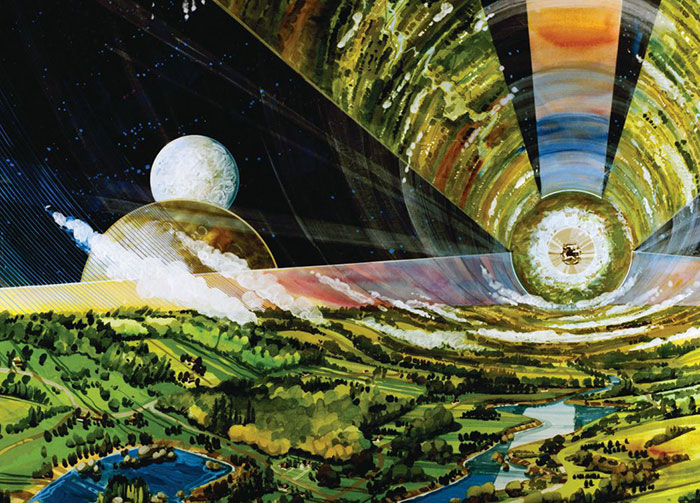
Gerard K O’Neill Cylinder Space Colony Concept (Credit: NASA/Rick Guidice, via Wikimedia Commons, Public Domain)
By Ignacio F. Bunster-Ossa, FASLA
Vice President, Landscape Urbanism and Resiliency at the Collaborative
Published January, 2022, For the Landscape Architecture Magazine
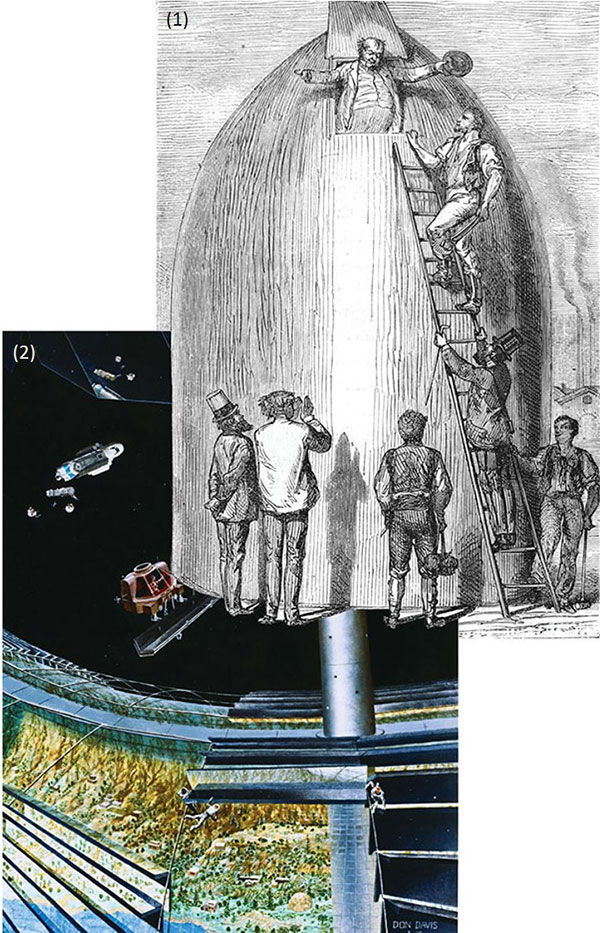
(1) From the Earth to the Moon, Jules Verne (Credit: De Montaut, via Wikimedia Commons, Public Domain) (2) Stanford Torus Space Colony Concept (Credit: Don Davis, via Wikimedia Commons, Public Domain)
Humanity has had a long-standing fascination with space travel. In Greek mythology, Apollo daily rode a gleaming chariot to pull the sun across the skies (hence the naming of NASA’s moon-landing program). Two millennia later, Jules Verne popularized the idea in Western culture with his 1865 book From the Earth to the Moon, a story that borrowed from artillery to lift people out into space. Then came Georges Méliès’s celebrated 1902 film, A Trip to the Moon. Inspired by Verne’s story, the film’s classic scene depicts a bullet wedged into the eye of a face-like moon. The Wright Brothers’ pioneering Kitty Hawk flight occurred one year after the Méliès film, and humanity has not stopped since in advancing better and more efficient ways to take to the skies and beyond.
The profession of landscape architecture emerged about the same time as space travel was taking an increasing hold in the Western public imagination. The construction of New York City’s Central Park was in full swing when Verne’s book came out, and Frederick Law Olmsted Jr. and others established ASLA in 1899, closely preceding the release of Mèliés’s film. To this writer, it is tempting to believe that rapidly industrializing societies, full of “can-do” bravado, saw the salutary proposition of recasting the landscape in the same way that stepping out of the bounds of the planet offered promise and hope for a better world. It has never been more urgent to examine this apparent conflation—improving our lot here on Earth while at the same time seeking to escape it.
My fascination with the subject of space dates to adolescence. Stanley Kubrick’s 2001: A Space Odyssey was awe-inspiring. Released in Cinerama, the 1968 film was impressive as much for its mystifying story as for the view of Earth from outer space.
Apollo 8 reached the moon that same year, sending back vivid images of Earth that rendered the film’s comparatively bleached depiction of the planet flat and lifeless. Still, the two feats—Kubrick’s masterpiece and Apollo’s lunar circumnavigation—melded fiction and nonfiction with an aura of inevitability. As with many young people back then, imagining life as an astronaut became my dream.
In the early 1970s, every student learning design was familiar with R. Buckminster Fuller. Fuller had invented the geodesic dome, a highly economical structure devised to enclose a living space. Technological efficiency was his mantra. His book Operating Manual for Spaceship Earth was a must read. But so was Ian McHarg’s Design with Nature. Both treatises were published in 1969, the year Neil Armstrong pronounced “one giant leap for mankind” from the Sea of Tranquility. The first-edition cover of McHarg’s book was all I needed to dive in: It depicted a polluted, grim world as an orb. Inside, a full-page photograph of Earth from space introduces the chapter titled “The World is a Capsule.” What more could an aspiring astronaut who instead would become a landscape architect—attending McHarg’s program at the University of Pennsylvania—ask for? McHarg equated the ecological design imperative with that of an astronaut who must learn the Earth’s “operating manual,” that is, its ecological intricacies, to survive. This is the message in “The World is a Capsule.” In his words, “We can use the astronaut as our instructor: he too is pursuing the same quest. His aspiration is survival—but then, so is ours.”
Fuller’s and McHarg’s teachings entwine the promises of technology and environmentalism to create a better, more sustainable world. But one might go back to 1962 to observe the beginnings of such entwinement. The Jetsons made their television debut that year, coinciding with the first meeting among world leaders to discuss the importance of protecting the world’s endangered species. The Convention on International Trade in Endangered Species of Wild Fauna and Flora was drafted a year later, but didn’t take effect until the mid-1970s. Over time it has accorded protection to more than 30,000 plant and animal species. At no time in history had the fantasy of living above the surface of the planet, complete with robots and flying cars, been matched by the urgency to protect the life down below.
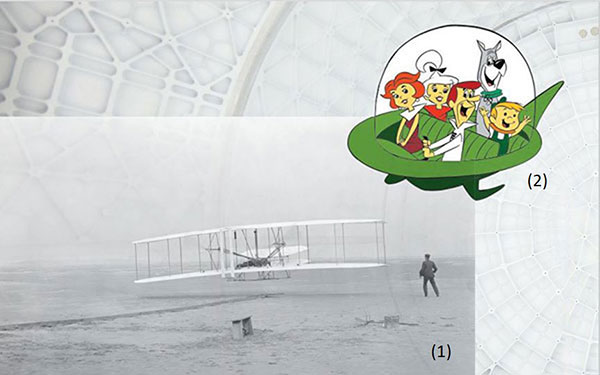
(1) The Wright Brothers’ Kitty Hawk Flight (Credit: John T. Daniels, via Wikimedia Commons, Public Domain) (2) The Jetsons (Credit: Picturelux/The Hollywood Archive/Alamy Stock Photo)
These seemingly opposing ideals, that is, the design of space habitats supported by life-sustaining landscapes, became a matter of serious research in the mid-1970s. A pioneering figure in this quest was Gerard K. O’Neill, a Princeton University physicist. His milestone book, The High Frontier: Human Colonies in Space, was published in 1976. The work details the means and methods by which humans could build town-like orbital stations, complete with parks and cropland. It remains a classic. A course on space colonization was available at the University of Pennsylvania in 1979, and McHarg enthusiastically allowed this student to take it for credit toward a Master of Landscape Architecture and Regional Planning degree. The High Frontier was our course textbook.
Then came Biosphere 2. Currently owned by the University of Arizona, the 1991 facility was built to show how humans could survive in an enclosed ecology, such as O’Neill posited. Nothing could enter or escape the geodesic-like research structures, including air, water, food, and waste; everything had to be recycled. The experiment collapsed in 1994, and interest in space colonization lay dormant for years.
Today interest has returned propelled by the technology entrepreneur Elon Musk’s SpaceX company and its goal to colonize Mars, and by Amazon founder Jeff Bezos’s Blue Origin and its vision to build orbital environments for millions of people. Bezos is a Princeton graduate and in the mid-1980s was one of O’Neill’s students; in 2018, Bezos received the Gerard K. O’Neill Memorial Award for Space Settlement Advocacy. Renderings of Bezos’s proposed space colonies depict towns and cities with flowing streams, meadows, and wilderness parks, the likes of which would have made McHarg smile. A corollary of Bezos’s space-bound visions is the transformation of a far-less-populated planet Earth into an ecological preserve.
Why all the fuss? Why the drive to go into space and over time relocate a portion of humanity—if not all of it—into orbit and/or another planet? There are three usual explanations. First, space travel and exploration are part of the quest to find humanity’s place in the universe and, thereby, explain our own existence. Second, space initiatives induce technological advancements that benefit all of society, such as those that occurred with the Apollo program. Lastly, humans are by nature exploring creatures, and space is, well, the final frontier.
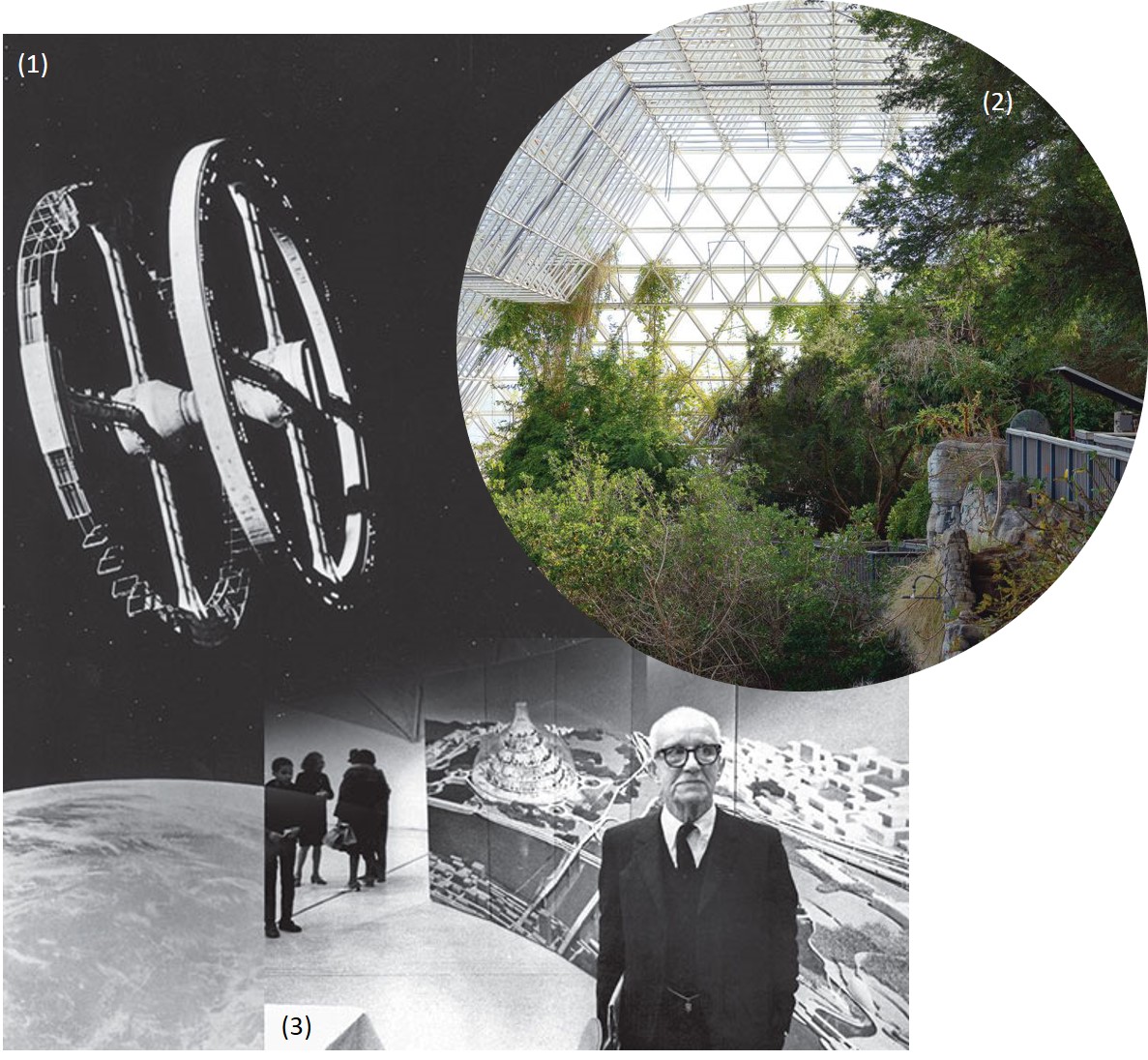
(1) Stanley Kubrick’s 2001: A Space Odyssey (Credit: 2001: A Space Odyssey Space Station, NASA on the Commons) (2) Biosphere 2 (Credit: HBarrison, Via Wikimedia Commons,CC By-SA 4.0 (https://creativecommons.org/licenses/by-sa/4.0/)) (3) R. Buckminster Fuller (Credit: Steve Yelvington, via Wikimedia Commons, CC By-SA 4.0 (https://creativecommons.org/licenses/by-sa/4.0/))
There is, however, a fourth and more profound reason, and that is, as McHarg says in Design with Nature, the survival of our species.
O’Neill believed as much. He was familiar with the environmental scholar Donella Meadows’s landmark book, The Limits to Growth (1972), and he saw space colonization, in the face of scarcity and pollution, as the only way for humanity to grow and thrive. He wrote: “In the modern view space will become a rich, new, Earthlike environmental range for humanity, bathed in continuous free energy.”
O’Neill had worked closely with NASA in the initial ideation of space colonies. According to recent statements from the space agency, the drive to make humanity a multiplanet species has been revalidated by the emergence of COVID-19 and “man-made catastrophes” (read: climate change). To Musk, Martian colonies simply may be essential to reduce the risk of human extinction.
But the poet Vicente García-Huidobro perhaps said it best. In 1931, well before the advent of rocketry, he wrote an epic poem called Altazor, or a Voyage in a Parachute. The title of the work combines the terms for altura (height) and azorado (bewildered), neatly pointing to what critics view as the work’s overarching theme: the inescapable fragility of the human condition.
“Oh yes I am Altazor, the great poet, without a horse that eats birdseed or warms its throat with moonbeams, with only my little parachute like a parasol over the planets.”
The words reference a precarious existence, lacking in earthly comforts and sustenance, destined to be adrift in space—drifting, as it were, toward nothingness.
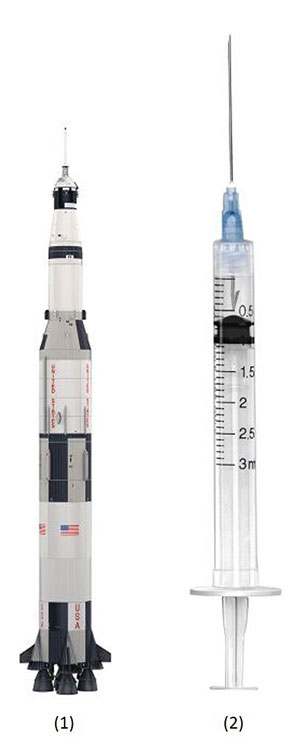
(1) Saturn V Rocket (Credit: Shutterstock.com/g/nerthuz) (2) Medical Syringe (Credit: Shutterstock.com/g/Iasha)
García-Huidobro might just as well have been referring to COVID-19. At the onset of the pandemic, the world faced fear and uncertainty—we were adrift without a parachute. Like McHarg’s imagined astronaut, there was an imperative to understand the nature of the virus: how it escapes its natural habitat, how it seeks a human host and attacks the immune system, and how from there it either kills or can be neutralized. It does not escape notice that a medical syringe and the Saturn V rocket that propelled astronauts to the moon, scaled to the same height, are proportionately similar. Both can be seen as essential instruments for survival.
This comparison suggests a fork in the road: Does humanity escape (the rocket) or hunker down (the syringe)? Do we dare forgo space and instead fix the land we presently occupy?
For the profession of landscape architecture, the choice is clear: We must fight to make the Earth a livable planet in the here and now. We must, in effect, become astronauts on our own planet, gaining and applying deep knowledge to the systems that support and sustain life. The world today is at the threshold of lasting and irreparable change. The planet is experiencing the greatest wave of extinctions since the disappearance of the dinosaurs—up to 150 species each day. COVID-19, too, has caused suffering and death. And as the World Health Organization affirms, a degradation in the health of ecosystems can only increase the chances of future zoonotic pandemics; further suffering of the population from animal-transmitted disease is sure to come. Piled on top of this is the near certainty that a decarbonized future will not be possible before the atmosphere heats up beyond 1.5 degrees Celsius from preindustrial levels, as the Paris Agreement predicts will happen by 2040 if current rates continue. In the face of such crises, the response of our profession must be decisive. There simply should be no planned or designed landscape that does not measurably advance humanity’s odds of survival—on this planet.
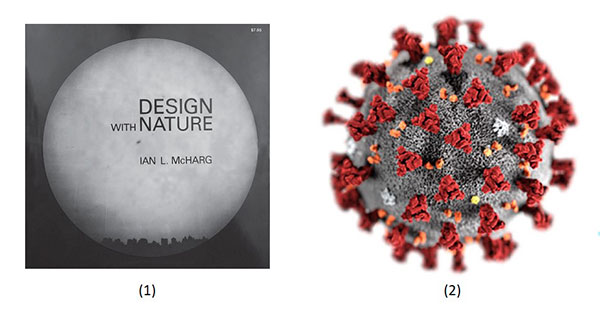
(1) Ian McHarg’s Design with Nature (Credit: Ian McHarg, Design with Nature) (2) COVID-19 Virus (Credit: Alissa Eckert, Ms; Dan Higgins, MAM, via Wikimedia Commons, Public Domain)
We must rigorously apply climate-positive design at all scales of practice, from gardens, streets, and plazas to parks, greenways, and waterways—making it all artful and beautiful, a thing to love. In practice, we must provide nature-based resilience focused on flood control, heat abatement, air and water quality, habitat restoration, and food security, prioritizing communities with the greater need. We must promote the growth of the urban forest as vital green infrastructure, but also as a vital source of health-inducing biophilia. We must sustain activism toward the protection and expansion of forests, peatlands, wetlands, and other critical natural habitats, especially to protect biodiversity and buffer the advance of disease vectors.
And we should do so with knowledge and use of advanced technology and information in every aspect of the work, including planning, design, construction, and monitoring. Let shame be cast upon planned or designed landscapes that do any less than this.
Any form of settlement in space, whether in orbit or in Mars, must be forced to meet absolute standards of self-sustainability, based in rigorous systems and biological expertise. Life in space depends on it. Why would anything else apply to habitation on Earth?
Link to the Source Article.


